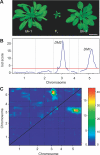Autoimmune response as a mechanism for a Dobzhansky-Muller-type incompatibility syndrome in plants
- PMID: 17803357
- PMCID: PMC1964774
- DOI: 10.1371/journal.pbio.0050236
Autoimmune response as a mechanism for a Dobzhansky-Muller-type incompatibility syndrome in plants
Abstract
Epistatic interactions between genes are a major factor in evolution. Hybrid necrosis is an example of a deleterious phenotype caused by epistatic interactions that is observed in many intra- and interspecific plant hybrids. A large number of hybrid necrosis cases share phenotypic similarities, suggesting a common underlying mechanism across a wide range of plant species. Here, we report that approximately 2% of intraspecific crosses in Arabidopsis thaliana yield F1 progeny that express necrosis when grown under conditions typical of their natural habitats. We show that several independent cases result from epistatic interactions that trigger autoimmune-like responses. In at least one case, an allele of an NB-LRR disease resistance gene homolog is both necessary and sufficient for the induction of hybrid necrosis, when combined with a specific allele at a second locus. The A. thaliana cases provide insights into the molecular causes of hybrid necrosis, and serve as a model for further investigation of intra- and interspecific incompatibilities caused by a simple epistatic interaction. Moreover, our finding that plant immune-system genes are involved in hybrid necrosis suggests that selective pressures related to host-pathogen conflict might cause the evolution of gene flow barriers in plants.
Conflict of interest statement
Figures





Comment in
-
Autoimmunity: a barrier to gene flow in plants?PLoS Biol. 2007 Sep;5(9):e262. doi: 10.1371/journal.pbio.0050262. Epub 2007 Sep 4. PLoS Biol. 2007. PMID: 20076688 Free PMC article. No abstract available.
References
-
- Chase CD. Cytoplasmic male sterility: A window to the world of plant mitochondrial-nuclear interactions. Trends Genet. 2007;23:81–90. - PubMed
-
- Bomblies K, Weigel D. Hybrid necrosis: Autoimmunity as a common barrier to gene flow in plants. Nat Rev Genet. 2007;8:382–393. - PubMed
-
- Coyne JA, Orr HA. Speciation. Sunderland (Massachusetts): Sinauer Associates; 2004. 545
-
- Ting CT, Tsaur SC, Wu ML, Wu CI. A rapidly evolving homeobox at the site of a hybrid sterility gene. Science. 1998;282:1501–1504. - PubMed
Publication types
MeSH terms
Grants and funding
LinkOut - more resources
Full Text Sources
Other Literature Sources
Molecular Biology Databases

